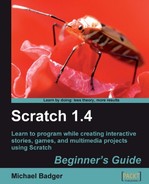When we create a new project, our first task is to add our cast of characters and props. Otherwise, we won't have any sprites to animate. Let's start by adding the most obvious part of a birthday card: "Happy Birthday."
- Open Scratch and click the New button to create a new Scratch project.
- Delete the cat sprite. In the sprites list, right-click on the cat and choose delete.
- Click on the paint new sprite button to display the Paint Editor.
- In the Paint Editor, choose the Text tool.

- A vertical blue bar displays in the editor to indicate we are able to type. Type Happy Birthday.
- If the text scrolls off the screen, use the horizontal and vertical scroll bars on the editor window to position the text in the editor window.
- Let's change the font and size. Highlight the text, and choose a font from the font drop-down list.
- Next select a font size. My example uses the font Ani, and I set the size to 36.
- Now, change the text color. Select a color from the color palette. Happy Birthday now displays in the color you selected. Refer to the following screenshot:

- Click on OK to close the Paint Editor and return to the stage.
The sprites list contains a new item labeled Sprite1.
We used the Paint Editor to create a simple, custom Happy Birthday sprite in the font, size, and color of our choosing.
Did you notice that as soon as you selected a new color, font, or size, the text immediately reflected your selection? The Paint Editor gave us a real-time preview of our work. When we clicked OK in the Paint Editor to save our sprite, the sprite on stage looked exactly as it did in the Paint Editor.
As we build our projects, thinking about how we program our games and stories is only part of the creative process. We need to design our user interface. In every project we create, we will make design choices about how our users view and use our projects.
When we choose colors, fonts, and size, we make decisions about typography, which affects our project design. Where we place a sprite on the stage, how we take our user through our project, and how we control our sprites are all design decisions.
For a real-world example of design, take a close look at the pages of this book. The use of headings to navigate chapters and how each heading displays including font, size, and color is a design. The margins on the page and the use of white space affect how the page is laid out, which in turn affects how easily you can read the material. Numbered and bulleted lists are a design choice.
Feel free to experiment with the design of your projects until you find something that looks good to you. You can always refine it later.
